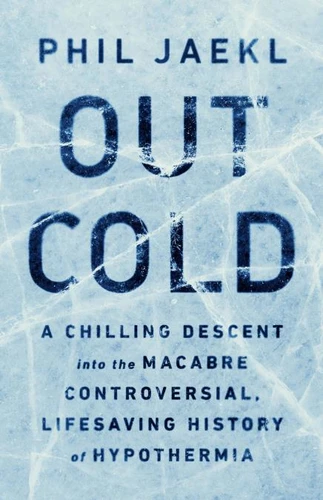Out Cold. A Chilling Descent into the Macabre, Controversial, Lifesaving History of Hypothermia
Par :Formats :
Disponible dans votre compte client Decitre ou Furet du Nord dès validation de votre commande. Le format ePub protégé est :
- Compatible avec une lecture sur My Vivlio (smartphone, tablette, ordinateur)
- Compatible avec une lecture sur liseuses Vivlio
- Pour les liseuses autres que Vivlio, vous devez utiliser le logiciel Adobe Digital Edition. Non compatible avec la lecture sur les liseuses Kindle, Remarkable et Sony
- Non compatible avec un achat hors France métropolitaine
 , qui est-ce ?
, qui est-ce ?Notre partenaire de plateforme de lecture numérique où vous retrouverez l'ensemble de vos ebooks gratuitement
Pour en savoir plus sur nos ebooks, consultez notre aide en ligne ici
- Nombre de pages272
- FormatePub
- ISBN978-1-5417-5672-4
- EAN9781541756724
- Date de parution31/05/2021
- Protection num.Adobe DRM
- Infos supplémentairesepub
- ÉditeurPublicAffairs
Résumé
"A fascinating look into the strange and sometimes unbelievable history of hypothermic medicine. Jaekl weaves together a story that is part history lesson and part science thriller. This is truly a must-read for any fan of science and science fiction!" -Douglas Talk, MD/MPH, chief medical consultant, SpaceWorks Inc., Human Torpor Project The meaning of the word "hypothermia" has Greek origins and roughly translates to "less heat." Its symptoms can be deadly-shivering, followed by confusion, irrationality, and even the illusion of feeling hot.
But hypothermia has another side-it can be therapeutic. In Out Cold, science writer Phil Jaekl chronicles the underappreciated story of human innovation with cold, from Ancient Egypt, where it was used to treat skin irritations, to eighteenth-century London, where scientists used it in their first explorations of suspended animation. Throughout history, physicians have used cold to innovate life extension, enable distant space missions, and explore consciousness. Hypothermia may still conjure macabre images, like the bodies littering Mt.
Everest and disembodied heads in cryo-freezers, but the reality is that modern science has invented numerous new life-saving cooling techniques based on what we've learned over the centuries. And Out Cold reveals a surprisingly warm future for this chilling state.
But hypothermia has another side-it can be therapeutic. In Out Cold, science writer Phil Jaekl chronicles the underappreciated story of human innovation with cold, from Ancient Egypt, where it was used to treat skin irritations, to eighteenth-century London, where scientists used it in their first explorations of suspended animation. Throughout history, physicians have used cold to innovate life extension, enable distant space missions, and explore consciousness. Hypothermia may still conjure macabre images, like the bodies littering Mt.
Everest and disembodied heads in cryo-freezers, but the reality is that modern science has invented numerous new life-saving cooling techniques based on what we've learned over the centuries. And Out Cold reveals a surprisingly warm future for this chilling state.
"A fascinating look into the strange and sometimes unbelievable history of hypothermic medicine. Jaekl weaves together a story that is part history lesson and part science thriller. This is truly a must-read for any fan of science and science fiction!" -Douglas Talk, MD/MPH, chief medical consultant, SpaceWorks Inc., Human Torpor Project The meaning of the word "hypothermia" has Greek origins and roughly translates to "less heat." Its symptoms can be deadly-shivering, followed by confusion, irrationality, and even the illusion of feeling hot.
But hypothermia has another side-it can be therapeutic. In Out Cold, science writer Phil Jaekl chronicles the underappreciated story of human innovation with cold, from Ancient Egypt, where it was used to treat skin irritations, to eighteenth-century London, where scientists used it in their first explorations of suspended animation. Throughout history, physicians have used cold to innovate life extension, enable distant space missions, and explore consciousness. Hypothermia may still conjure macabre images, like the bodies littering Mt.
Everest and disembodied heads in cryo-freezers, but the reality is that modern science has invented numerous new life-saving cooling techniques based on what we've learned over the centuries. And Out Cold reveals a surprisingly warm future for this chilling state.
But hypothermia has another side-it can be therapeutic. In Out Cold, science writer Phil Jaekl chronicles the underappreciated story of human innovation with cold, from Ancient Egypt, where it was used to treat skin irritations, to eighteenth-century London, where scientists used it in their first explorations of suspended animation. Throughout history, physicians have used cold to innovate life extension, enable distant space missions, and explore consciousness. Hypothermia may still conjure macabre images, like the bodies littering Mt.
Everest and disembodied heads in cryo-freezers, but the reality is that modern science has invented numerous new life-saving cooling techniques based on what we've learned over the centuries. And Out Cold reveals a surprisingly warm future for this chilling state.



